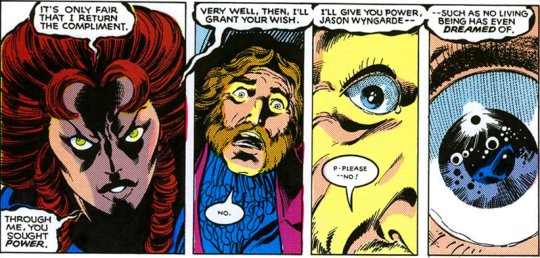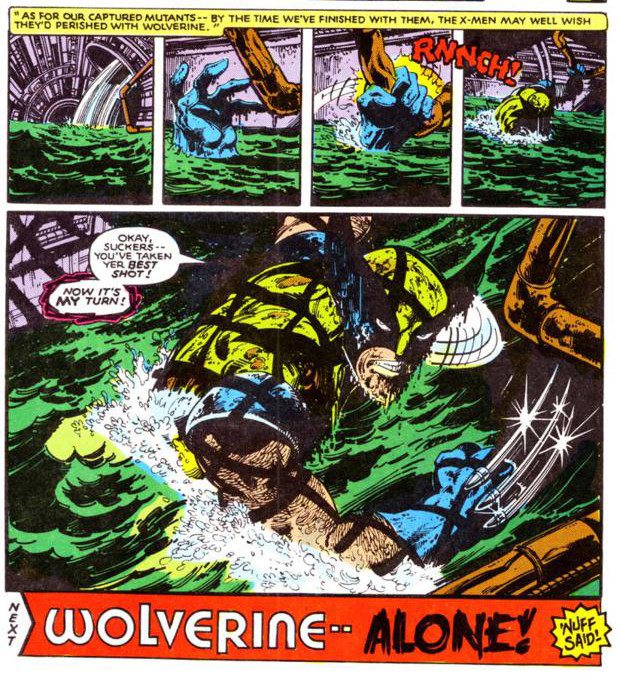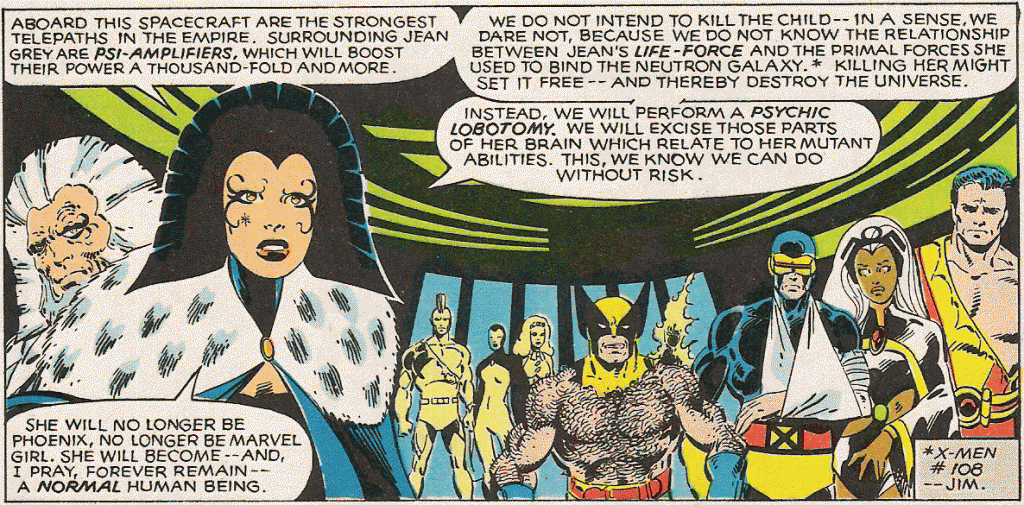With the release of the first X-Men film in 2000, audiences not only witnessed the dawn of the modern day superhero film boom, but also the beginning of a complicated franchise that would span sixteen years and nine films. With X-Men: Apocalypse on the horizon, Kayleigh Hearn and a rotating cast of merry mutants are revisiting the X-Men films from the very beginning, and examining the comic book storylines that inspired them. What would you prefer, yellow spandex?
“The Dark Phoenix Saga,” Uncanny X-Men #129-#138 (1980)
By Chris Claremont and John Byrne
Kayleigh: The Dark Phoenix Saga! Four of the biggest words in X-Men history. Like many X-Men fans growing up in the ‘90s, my first experience with The Dark Phoenix Saga was the bowdlerized version from the Fox animated series, but reading the original comic years later I found that the story lost none of its power. This is a comic that literally shoots for the stars and is cosmically epic–and yet it succeeds as a very human story, too. It represents the X-Men’s greatest victory and their greatest loss, and it cemented Jean Grey as one of my favorite superheroes of all time.
Dylan: Any X-Men fan owes it to themselves to read The Dark Phoenix Saga—really, the whole Chris Claremont run through at least Uncanny X-Men #200, if you ask me, though Kayleigh, you’ve explored the whole canon and may be able to make an even broader recommendation. Is this as good as it gets? Of the literal thousands of X-Men stories out there, is there any one that is as packed with what makes X-Men, X-Men?
Kayleigh: In my mind, the only story that would rival The Dark Phoenix Saga is Days of Future Past–which was, amazingly enough, published only three issues after Saga‘s end. Days of Future Past explores the X-Men’s theme of misfits struggling against societal persecution more than The Dark Phoenix Saga does, but this is a story of immense scope and importance for the franchise. For example, these issues have the first appearances of Kitty Pryde, Emma Frost, Dazzler, and the Hellfire Club, all before Dark Phoenix herself shows up!
Dylan: Since Claremont’s X-Men run tended to have storylines flow seamlessly into one another (a far cry from the six-issue trade-ready arcs we enjoy today), it’s possible for this one chunk of issues to include *ahem:*
- A fight at a disco
- Political intrigue
- 18th Century erotic friendfiction
- An extraterrestrial gladiator match
- Guys getting hella stabbed in a sewer
- A decades-old heroine casually eating a sun and killing a whole planet
It helps that each story page has eight to twelve panels that are absolutely packed with captions and dialogue in a way that we’d never permit in modern comics. And beyond the introductions of all those characters you mention, it’s also the story in which Wolverine really becomes the badass we know and love, and the arc isn’t even about him. It’s that epic.
Kayleigh: I absolutely love Claremont’s ultra-compressed, super verbose writing style–Uncanny X-Men is a soap opera in the best possible way, right down to the “Cyclops is dead!” fakeout cliffhanger ending. Wolverine’s “Now it’s MY turn!” moment is just SO iconic I’m genuinely surprised none of the X-Men or Wolverine movies have touched it.
John Byrne’s art throughout The Dark Phoenix Saga is consistently stunning–just think of every artist who’s ever homaged Wolverine in the sewers, or the cover of UXM #137, and you begin to get an idea of how important and iconic these issues are. Besides breathtaking action sequences, I’m a huge fan of his character work. Kitty Pryde is fully believable as a plucky suburban teenager, Emma Frost and the Black Queen have been, well, sex symbols for comic geeks for decades, and Jean Grey as Dark Phoenix is both beautiful and terrifying. He turns a character the readers have known and loved for years into a cosmic, sun-devouring monster, but at the same time Jean never loses our sympathy.
Dylan: Let’s talk about Jean Grey’s arc in this story. So, she’s recently come back from the dead with some amazing new powers that she’s just barely been able to keep under control. Then along comes Jason “Mastermind” Wyngaard, whose dastardly plan is to seduce Jean with a fake past life experience that will make her really into leather. He believes that he can use his illusions to use her to seize control over the Hellfire Club (and then the world), but little does he know that getting Jean in touch with her inner fetish queen will also unleash the full power of the cosmic superbeing within.
Said superbeing, the Dark Phoenix, tunes up the X-Men and kills a whole planet mostly just because, attracting the attention of the Shi’ar Empire, who want to execute her before she can do more damage. But once Jean gets control over herself again, she realizes that she’s too dangerous to be left alive, and orchestrates a grand goodbye for herself to save the Earth, her family, and the man she loves. And, while you’re reading, it, it all makes sense.
Kayleigh: Jean Grey’s arc is the perfect culmination of years of character development, from her demure days as the “token girl” of the original X-Men to an older, passionate woman whose immense power was equal to her love for her friends. One criticism of The Dark Phoenix Saga is that it’s an example of the “woman goes crazy because she can’t control her power” cliche, though I think that reading is a tad reductive. (The story certainly doesn’t let the men who tried to control her and failed–Mastermind and Professor X–off the hook for what happens to her.) Jean isn’t the passive pawn we see in X-Men: The Last Stand, and her agency is key here. Jean chooses to end her life to save the universe, and the story of the Phoenix comes full circle–Jean became Phoenix to save the life of her loved ones, and she ends her life as Phoenix also to save them.
This ending is so perfect and operatic in its tragedy that it’s kind of amazing that this wasn’t even the original ending, but something hastily re-written and re-drawn after an editorial mandate decreed that Jean had to die for Dark Phoenix’s crimes. The original ending where Jean lives, but is permanently depowered and meekly shuffled off to a domestic life with Cyclops, would have been in a way a fate worse than death. (Just ask Madelyne Pryor.) I actually have no problem with Jean’s later resurrection–she’s named Phoenix, come on–but this is the right ending for Dark Phoenix, and it’s amazing just how badly X-Men: The Last Stand missed the point.
Dylan: Comic book superheroes don’t get to retire off to the country and have kids. Maybe if that’s what had ended up happening with Jean and Scott that would have set a precedent, and we would have seen more characters across Marvel and DC shrug off the demands of the marketing machine and the sliding timescale to make room for new characters, the way Claremont had always planned for his X-Men. But Jean’s transformation, her sacrifice, it set the standard for how you say goodbye to a hero. They die, hopefully in a way that serves their character, their companions grieve and struggle and move on, and then when the story demands (or when they have a movie coming out), they come back to life with new powers and a new costume. Jean Grey is Comic Book Death incarnate.
Kayleigh: I don’t think any of us in 2006 realistically expected a faithful adaptation of The Dark Phoenix Saga, complete with bird people aliens, cosmic forces, and a gladiatorial match on the surface of the moon. But it would have been great to have a film that matched its scope and ambition, and depicted a battle for a woman’s soul, without losing sight of her as a character. Instead we got a dull, disappointing film version of one of those ugly little superhero mash-up toys.
Dylan: But, like the Phoenix herself, Jean Grey will return once more, in X-Men: Apocalypse, and if the box office gods permit, many sequels to come. And (particularly considering how much The Donner Company and 20th Century Fox have disowned The Last Stand) I fully expect that we’ll get a more faithful screen adaptation of The Dark Phoenix Saga, say, some time around 2021. After the Age of Apocalypse, where else can the X-Men film franchise go other than to bird people aliens?
Kayleigh: But we’re still not done! Come back tomorrow for part three of our coverage of X-Men: The Last Stand as we review its second source of inspiration–Joss Whedon and John Cassaday’s Astonishing X-Men!






